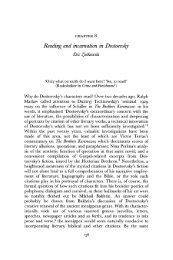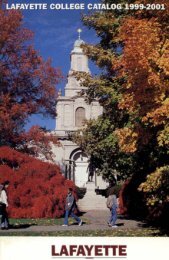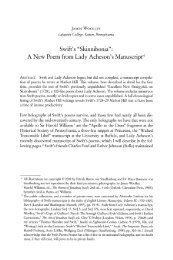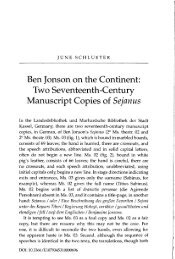Create successful ePaper yourself
Turn your PDF publications into a flip-book with our unique Google optimized e-Paper software.
196 JUNE SCHLUETER<br />
persons, including Robert Browne, John Green, Robert Ledbetter, 12 and other<br />
players from Moritz’s court, were, once again, at the Frankfurt fair, after<br />
which they returned to Kassel. 13 The journey (of six days?) would likely have<br />
taken them to—or at least through—Marburg.<br />
The scenario, though grounded in archival materials, is imaginary, for<br />
there is no known record of the English actors in Marburg in 1605–6. Nonetheless,<br />
it is not unlikely. Two letters from 1597 establish a connection between<br />
the Landgrave Moritz and theatrical activity in Marburg. The first<br />
indicates that Moritz lent Landgrave Ludwig of Marburg costumes and properties<br />
in order that the comedy of the Old Potentates might be performed; it<br />
was a performance that Moritz himself hoped to attend. The second records<br />
Ludwig’s return of the costumes and properties to Moritz following a performance<br />
that was seen by Grave Hans Ernest von Solms. 14 Alternatively,<br />
Hartmann could have seen the actors in Kassel, at the Frankfurt fair, or elsewhere;<br />
sufficiently intrigued, he could have had the players painted in his<br />
album. <strong>Album</strong>s, after all, were not only records of one’s circle of acquaintances<br />
and one’s travels, prompted by motives similar to those of modernday<br />
autograph seekers and vacation photographers; they were also acts of<br />
self-representation, designed to draw attention to the album owner as a man<br />
of experience and learning: perhaps the album owner here wished to show<br />
his knowledge of something his friends may not have seen. Or perhaps he<br />
was still excited over having seen the players perform. For despite Fynes Moryson’s<br />
disdain for the English actors he saw at the Frankfurt fair in 1592,<br />
the English traveler did remark on the undiscriminating German audience,<br />
who ‘‘flocked wonderfully to see theire gesture and Action.’’ 15 And Balthasar<br />
Baumgartner the Younger, of Nuremberg, who also saw the players at the<br />
Frankfurt fair in 1592, reported in a letter to his wife that he was greatly<br />
impressed with the English comedians’ music and their talents at leaping and<br />
dancing. (He also mentioned that they were ‘‘khöstlich herrlich wol<br />
geklayded’’—wonderfully splendidly dressed.) 16 Either way, Hartmann’s<br />
album <strong>amicorum</strong> offered him an opportunity to create a pictorial record of<br />
the traveling troupe.<br />
But what of the painting itself? What can we learn from the figures on the<br />
horses and the two masked figures that lead them? Of immediate interest is<br />
the representation of gender: clearly the crowned player in red, with flowing<br />
hair, is intended to be a princess or queen. But what of the figure who brings<br />
up the rear? Is this a boy actor, dressed in a woman’s skirt? (Note that neither<br />
he/she nor the princess/queen is riding sidesaddle.) And what of the other<br />
two, in green and blue? Are they, too, in skirts, or are they in men’s robes?<br />
(The horses’ heads obscure the line of the fabric.) Three of the players on<br />
horseback wear plumed helmets: what should we make of their headgear?<br />
And what of the properties they carry? The falcon that sits on one player’s<br />
fist may or may not be alive, but it is clearly outfitted for hawking, with hood,<br />
................. 16818$ $CH7 05-30-08 13:47:56 PS<br />
PAGE 196











